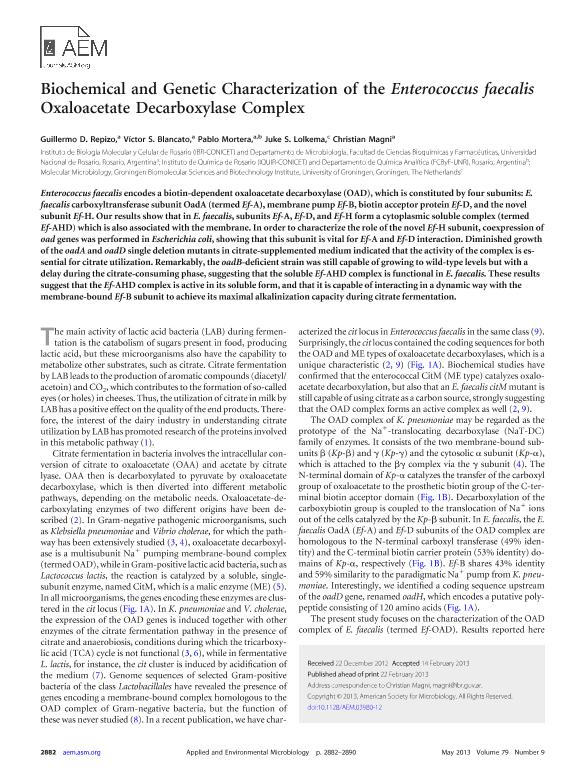Artículo
Biochemical and genetic characterization of the Enterococcus faecalis Oxaloacetate decarboxylase complex
Repizo, Guillermo Daniel ; Blancato, Victor Sebastian
; Blancato, Victor Sebastian ; Mortera, Pablo
; Mortera, Pablo ; Lolkema, Juke; Magni, Christian
; Lolkema, Juke; Magni, Christian
 ; Blancato, Victor Sebastian
; Blancato, Victor Sebastian ; Mortera, Pablo
; Mortera, Pablo ; Lolkema, Juke; Magni, Christian
; Lolkema, Juke; Magni, Christian
Fecha de publicación:
05/2013
Editorial:
American Society for Microbiology
Revista:
Applied And Environmental Microbiology
ISSN:
0099-2240
Idioma:
Inglés
Tipo de recurso:
Artículo publicado
Clasificación temática:
Resumen
Enterococcus faecalis encodes a biotin-dependent oxaloacetate decarboxylase (OAD), which is constituted by four subunits: E. faecalis carboxyltransferase subunit OadA (termed Ef-A), membrane pump Ef-B, biotin acceptor protein Ef-D, and the novel subunit Ef-H. Our results show that in E. faecalis, subunits Ef-A, Ef-D, and Ef-H form a cytoplasmic soluble complex (termed Ef-AHD) which is also associated with the membrane. In order to characterize the role of the novel Ef-H subunit, coexpression of oad genes was performed in Escherichia coli, showing that this subunit is vital for Ef-A and Ef-D interaction. Diminished growth of the oadA and oadD single deletion mutants in citrate-supplemented medium indicated that the activity of the complex is essential for citrate utilization. Remarkably, the oadB-deficient strain was still capable of growing to wild-type levels but with a delay during the citrate-consuming phase, suggesting that the soluble Ef-AHD complex is functional in E. faecalis. These results suggest that the Ef-AHD complex is active in its soluble form, and that it is capable of interacting in a dynamic way with the membrane-bound Ef-B subunit to achieve its maximal alkalinization capacity during citrate fermentation.
Palabras clave:
ENTEROCOCCUS
,
OXALOACETATE
,
DECARBOXILASE
,
CITRATE
Archivos asociados
Licencia
Identificadores
Colecciones
Articulos(IBR)
Articulos de INST.DE BIOLOGIA MOLECULAR Y CELULAR DE ROSARIO
Articulos de INST.DE BIOLOGIA MOLECULAR Y CELULAR DE ROSARIO
Articulos(IQUIR)
Articulos de INST.DE QUIMICA ROSARIO
Articulos de INST.DE QUIMICA ROSARIO
Citación
Repizo, Guillermo Daniel; Blancato, Victor Sebastian; Mortera, Pablo; Lolkema, Juke; Magni, Christian; Biochemical and genetic characterization of the Enterococcus faecalis Oxaloacetate decarboxylase complex; American Society for Microbiology; Applied And Environmental Microbiology; 79; 9; 5-2013; 2882-2890
Compartir
Altmétricas



